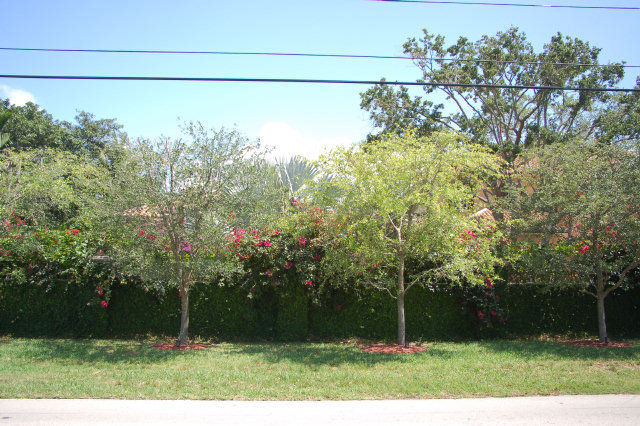The live oak is a Florida favorite

As published in The Miami Herald
There are estimated to be more than 500 species of oaks, but if you make your home in South Florida’s distinctive climate, you most likely are familiar with only one — the live oak, Quercus virginiana, the only oak in South Florida that truly becomes a tree, reaching heights of 60 feet with a spread as wide or greater.
The live oak, which ranges as far north as Virginia (hence the specific epithet virginiana) and as far west as Texas, is very well adapted to South Florida because it can take our limestone soil, our dry winters and wet summers. It also has a deep root system and sturdy branches that help it withstand hurricane force winds.
 |
| These oaks are doomed to a lifetime of costly pruning as they were planted directly under power lines. The oak in the background shows what could have been. |
Introduce our live oak to a visitor from the north, and he or she might not even recognize it as an oak, as it does not possess the typical lobed oak leaf shape. Instead it has a very ho-hum, but durable, oval-shaped leaf.
The live oak is one of the largest native trees in South Florida. Its thick, undulating bark is often home to stunning orchids, mosses, ferns, lichens, bromeliads and any other epiphyte or tree clinger that guides its seed or spore into the welcoming arms of the mighty oak. When grown correctly, with the proper space and light, the live oak can add value to your home with years of beauty and precious shade.
 |
| Oak abuse is rampant. This unlucky oak was not watered after it was planted and slowly died. |
Oaks are hardwood trees, which means they are somewhat slow-growing and consequently have very dense wood. In the natural world, density equals durability, so oak has been used for everything from flooring and whiskey barrels to boat decks and furniture.
Density and durability can also translate to a tree holding up well in a powerful windstorm. This was on full display in August of 1992 when Category 5 Hurricane Andrew barreled through and laid waste to brittle, poorly rooted trees and shoddily built homes.
Because the many live oaks already growing in South Florida in 1992 held up so well to the 150 mph winds, the live oak was the overwhelming street tree of choice when Miami-Dade County began to rebuild and replant. The city planners were correct in recognizing the oak as an excellent tree for the area, but apparently gave very little thought as to the space requirements of the thousands of oaks that were hastily planted across the storm-ravaged landscape.
The live oak quickly became one of the most abused trees in South Florida. It was often planted directly under power lines, next to buildings and wedged ever so precariously into tiny medians that had no more business being home to the root system of a massive oak than a tiny clay pot does. You simply cannot fit a 60-foot tree in a 10-foot space. Unfortunately, this abuse goes on to this day as new oak plantings still end up under eaves and power lines and sardined into strip mall parking lots.
 |
| The undulating bark of the live oak makes it a perfect place for many types of epiphytes. |
The oaks that were planted under power lines have needed costly annual pruning and will never become the majestic and powerful trees they were meant to be. Oaks crammed into parking lots and medians have either withered away without the space they need to thrive, or they have burst free of their underground prisons by breaking roads and curbs with their massive roots.
In sharp contrast to their abused brethren, oaks that were planted in open areas with plenty of space and sunlight (their water needs are very low) have thrived and produce an abundance of shade. They provide shelter, food and even homes for our native flora and fauna.
Given the right amount of space and light, the oak is the gold standard for South Florida shade trees. But if the oak is abused by lack of space or sunlight, it suffers.
The take-home lesson is simple: Put the right plant in the right location and you will be fine. Know the ultimate size and light requirements of what you want to plant before you decide where you will put it and you will immediately be a better grower.
